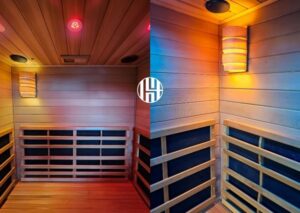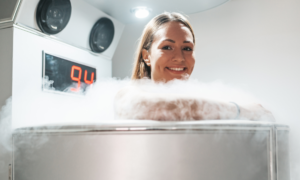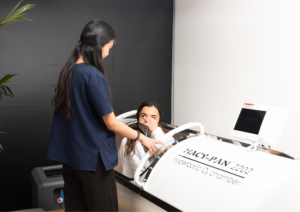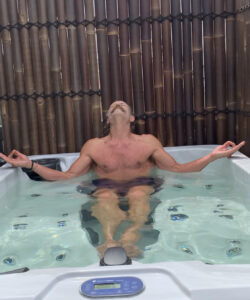Spinal aching can be caused by a variety of factors, and it’s important to identify the root cause to address it effectively. Referred pain in the leg can be caused by several underlying conditions related to the spine, muscles, or nerves for example Herniated Disc. Spinal Stenosis, Sacroiliac Joint Dysfunction, Piriformis Syndrome etc.

ICE BATH
An Ice Bath session can be a full body immersion or just immersion of the affected area of your body. The temperature of our Ice Bath varies between .2 of a degree Celsius to one degree. We recommend that the perfect target time for immersion is 3 minutes, but this can be varied according to your tolerance. For a full body immersion, we recommend our breathing exercises as a warmup to the treatment. This increases the oxygen content in your blood for the maximum benefit of the extreme cold and increase your tolerance.

Effect:
The benefit of ice bath for a recovering injury or chronic pain is the treatment of cold on the muscle, tissue, and flow of blood through the affected area. With most pain or stress related issues the affected area will become inflamed and/or swollen. The cold reduces this problem and allows high concentrations of oxygen to enter the affected area which expediates recovery.
Treatments:
The number of treatments recommended will vary according to the severity of the problem. A single treatment may alleviate pain immediately but most likely will not fix the problem long term.
For injury recovery we would recommend a regular immersion perhaps each day until recovery or at least twice a week. Open wound is not allowed, An open wound could become infected more easily.
For chronic pain problems you may require sessions when pain returns. For all injuries of severity or chronic pain issues we recommend expert medical evaluation combined with regular ice bath treatments.
Complimentary Treatments:
Ice Bath treatments can be combined very successfully with HBOT (recommended prior to ice bath), Infra-red sauna or Magnesium Hot Spa (to follow ice bath), or remedial massage (either before or after).
Combining ice bath with another of these treatments multiplies the effect by increasing oxygen flow through the blood stimulating the healing process.
INFRARED SAUNA
Infrared saunas use infrared light to heat the body directly, rather than heating the air around you. This can penetrate deeper into tissues and muscles, potentially offering different benefits compared to traditional saunas. The most important aspect of Infrared Sauna are the rays passing into your body tissue and not the overall heat. The heating effect of the infrared on the body will assist with the relaxation of the body tissue and give you an overall warm relaxing feeling.

Effect:
The heat from infrared saunas can dilate blood vessels and increase circulation. Enhanced blood flow can help deliver more oxygen and nutrients to injured tissues, promoting faster healing. Infrared heat can help relax muscles and ease stiffness, which may alleviate pain and improve range of motion in the injured area. The heat can help reduce inflammation by improving circulation and promoting the removal of metabolic waste products from the tissues.
Sweating induced by the sauna can help flush out toxins, which might contribute to overall healing and recovery.
Treatments:
We recommend a first treatment of 20-30 minutes at 46-55 degrees Celsius with colours like blue and green are thought to have calming effects, which could potentially help reduce the perception of pain. And violet is believed to have soothing properties that can promote relaxation and reduce stress, potentially aiding in overall recovery. You generally require a regular treatment of at least one session every two days depending on soreness, but you should notice an immediate relief after the first session. You can extend your sessions to 60 minutes gradually.
Complimentary Treatments:
Infrared sauna treatments can be combined very successfully with HBOT (recommended prior to your infrared sauna), Ice bath or Magnesium Hot Spa (before infrared sauna), or remedial massage (either before or after).
Combining infrared sauna with another of these treatments multiplies the effect by increasing lubrication, decreasing swelling and destroying toxins in the body.
CRYOTHERAPY
Cryotherapy, which involves exposing the body to extremely cold temperatures for a short period 1-3 minutes, can offer several benefits for muscle soreness. Athletes use it to numb nerve irritation and treat injuries, as the cold desensitises irritated nerves, providing relief for conditions like pinched nerves and chronic pain.

Effect:
- Reduces Inflammation: Cold temperatures help constrict blood vessels and reduce blood flow to the affected area, which can decrease inflammation and swelling that contribute to muscle soreness.
- Dulls Pain: Cryotherapy can numb the area, which helps reduce the sensation of pain. This analgesic effect can make it easier to manage discomfort from muscle soreness.
- Speeds Up Recovery: By reducing inflammation and pain, cryotherapy can help accelerate the recovery process. Athletes and active individuals often use it to recover more quickly between workouts or competitions.
- Decreases Muscle Spasms: Cold therapy can help reduce muscle spasms and tightness, which are common after intense physical activity.
- Enhances Circulation: When you exit the cold environment, your body works to warm up, causing a rebound increase in blood flow. This enhanced circulation can help with the delivery of nutrients and removal of waste products from the muscles.
- Improves Range of Motion: By alleviating soreness and stiffness, cryotherapy can help maintain or improve flexibility and range of motion in the affected muscles.
Treatments:
If the goal is to support general muscle recovery and manage soreness, using the cryochamber once a week or every other week may be sufficient. If recovering from an injury or dealing with chronic pain, more frequent sessions, such as 3-4 times a week, might be recommended, but this should be tailored to individual needs in consultation with a healthcare professional.
Complimentary Treatments:
It’s often used in combination with other recovery strategies like stretching, alternating between cold and heat therapy can be beneficial. Heat from either infrared sauna or magnesium hot spa help relax and loosen muscles, while cryotherapy reduces inflammation. Using heat warm baths after cryotherapy can provide additional relief.
HYPERBARIC OXYGEN THERAPY (HBOT)
Hyperbaric oxygen therapy (HBOT) involves breathing pure oxygen in a pressurized environment. The chamber is gradually pressurized to the desired level, typically between 1.5 to 2 times the normal atmospheric pressure. This process of pressurization can take about 10-15 minutes, and the increase in pressure on the body enhances the ability for tissue and blood to absorb oxygen which will in turn promote accelerated healing. Sessions usually last between 60 to 90 minutes, but this can vary depending on the condition being treated.
It's been used for various medical conditions, including chronic wounds and injury repair where the additional oxygen supplied to the affected area promotes growth of new healthy cells.

Effect:
- Increased Oxygen Delivery: HBOT involves breathing pure oxygen in a pressurized environment, which significantly enhances the amount of oxygen dissolved in the blood. This higher oxygen availability can help tissues repair and regenerate.
- Reduced Inflammation: The therapy can reduce inflammation, which is often a factor in nerve damage and slows healing.
- Enhanced Cell Function: It may stimulate the production of growth factors and enhance cellular repair mechanisms.
- It may support recovery in cases of acute nerve injuries by reducing secondary damage and promoting healing processes.
- Potential Pain Relief: HBOT may have an analgesic effect by reducing inflammation and modulating pain pathways. This could lead to a reduction in the sensation of muscle soreness.
Treatments:
Some studies suggest starting with 1-2 sessions per week for muscle recovery. This allows time for the body to adapt and respond to the therapy. Frequency might be increased to 3-5 sessions per week. Depending on the intensity of your exercise regimen and recovery needs,
Complimentary Treatments:
HBOT treatments can be combined very successfully with Ice Bath (recommended prior to ice bath), Infra-red sauna support detoxification processes or Magnesium Hot Spa (to follow ice bath), or remedial massage (either before or after). Combining massage with HBOT can enhance blood flow and oxygen delivery to muscles, potentially improving recovery from exercise-induced damage and reducing soreness.
MASSAGE
Massage therapy can significantly impact muscle and joint, offering a range of benefits that support recovery and improve overall well-being. It is very important to use only a qualified Masseuse and the higher level of their experience and education will provide you with a safer and more satisfactory solution.

Effect:
Massage enhances blood flow to the injured area, which helps deliver oxygen and nutrients necessary for tissue repair and removes metabolic waste products. Increased circulation can promote faster healing and reduce recovery time.
Massage helps relax tight muscles and alleviate muscle spasms by targeting trigger points and reducing muscle tension.
Massage stimulates the release of endorphins, which are natural painkillers. It also helps disrupt pain signals being sent to the brain. Pain relief can make it easier for individuals to engage in rehabilitation exercises and activities.
Massage promotes relaxation and reduces stress by lowering cortisol levels and increasing serotonin and dopamine levels. Lower stress levels can improve overall well-being and support the body's natural healing processes.
Promotes Scar Tissue Remodelling. Post-injury, massage can help break down scar tissue and adhesions, which may form as part of the healing process.
Treatments:
Combining both remedial and therapeutic massage can provide a comprehensive approach to managing muscle and joint soreness. Remedial massage can address specific issues, while therapeutic massage can support overall relaxation and recovery.
Complimentary Treatments:
Combining massage with HBOT can enhance blood flow and oxygen delivery to muscles, potentially improving recovery from exercise-induced damage and reducing soreness.
Using the infrared sauna or magnesium spa before your massage can help relax your muscles, making the massage more effective. After a massage, the infrared sauna can help continue the relaxation process and further reduce muscle soreness. It can also help in detoxifying any residual tension or metabolic waste released during the massage. Uses colors and light to balance energy and promote healing. Red light improve circulation and potentially help in healing tissues. Blue light might help reduce stress and promote relaxation. Green light might help with overall muscle recovery and regeneration.
Use cryotherapy (like ice baths, cryochambers) after a massage to help with muscle recovery and relaxation.
MAGNESIUM HOT SPA
Magnesium hot spa, or baths with magnesium-rich water, are often used for relaxation and to address various health concerns. Magnesium is a mineral that plays a crucial role in many bodily functions, including muscle and nerve function, bone health, and the regulation of sleep.

Effect:
- Muscle Relaxation: Magnesium is known for its muscle-relaxing properties. When absorbed through the skin, it can help reduce muscle tension and cramps, which might be contributing to your pain.
- Pain Relief: The heat from a hot spa can increase blood flow to the affected areas, which might help alleviate pain and promote healing. The combination of heat and magnesium may provide additional relief by reducing inflammation and promoting muscle relaxation.
- Improved Sleep: Magnesium can also support better sleep, which is crucial for recovery and pain management.
- Stress Reduction: The soothing effects of a hot spa can help lower stress levels, which can contribute to overall pain relief and well-being.
Treatments:
Limit your time in the hot spa to avoid overheating or dehydration. Typically, 15-30 minutes is sufficient.
Complimentary Treatments:
Magnesium hot spas can be combined very successfully with HBOT which can enhance blood flow and oxygen delivery to muscles, potentially improving recovery from exercise-induced damage and reducing soreness. Heat and Cold Therapy: like ice bath, cryotherapy or infrared sauna can help manage inflammation and soothe pain and support detoxification processes. Therapeutic massage can help relieve muscle tension, improve circulation, and reduce pain in the spinal area.